In this post, you’ll learn what is wind turbine and how it works? and two different types of wind turbine explained with advantages and applications.
Also, you can download the PDF file at the end of this article.
What is a Wind Turbine?
A wind turbine is a mechanical machine that converts the kinetic energy of fast-moving winds into electrical energy. The energy converted is based on the axis of rotation of the blades.
The small turbines are used for applications such as battery charging for auxiliary power for boats or caravans or to power traffic warning signs. Slightly larger turbines can be used to contribute to the domestic electricity supply while selling unused power back to the utility supplier through the power grid.
Arrays of large turbines known as wind farms are becoming an essential source of intermittent renewable energy. These are used by several countries as part of a strategy to reduce dependence on fossil fuels.
Hundreds of thousands of large turbines in installations are known as wind farms. Currently, it generates more than 650 gigawatts of electricity, with 60 gigawatts added each year. It is also possible to categorize wind turbines based on how they convert wind energy into electrical energy.
Let’s take a closer look at the key components of a wind turbine below.
Read Also: How Does a Reaction Turbine Work? Parts, Types & Applications
Parts of Wind Turbine
The following are the parts of the wind turbine:
- Blades
- The rotor
- Nacelle
- A gearbox and coupling (transmission system)
- Aeroturbine
- Controller
- Electrical generator
- Supporting structure.
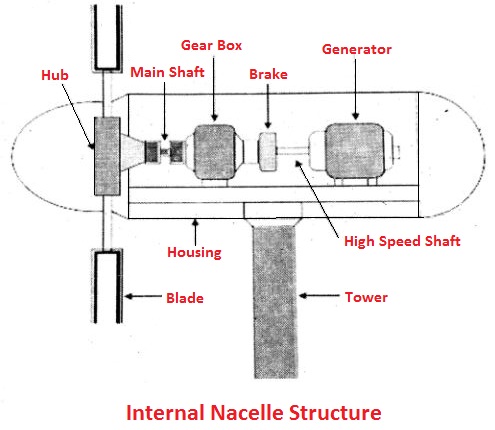
#1 Blades
Lifting-style wind turbine blades. These are designed most efficiently to capture the energy of solid and fast winds. Some European companies manufacture single-blade turbines.
#2 The Rotor
The rotor is aerodynamically designed to occupy the maximum surface area of the wind to spin the most ergonomically. The blades are lightweight, durable, and corrosion-resistant material. The best materials are composites of fiberglass and reinforced plastic.
#3 Nacelle
A housing containing all the components essential to operate the turbine efficiently is called a nacelle. It is mounted on top of a tower and includes gearboxes, low and high-speed shafts, generators, controllers, and brakes. The wind vane and wind speed anemometer are mounted on the nacelle.
Nacelle provides housing for:
- Low-speed shaft
- Brake
- Gearbox
- High-speed shaft
- Generator
- Anemometer
- Wind vane.
Read Also: What are the different types of conveyor systems? [PDF]
#4 A Gearbox and Coupling (Transmission System)
A gearbox magnifies or amplifies the energy output of the rotor. The gearbox is located between the rotor and the generator. A rotor rotates the generator as guided by the tail pane.
#5 Aeroturbine
Aeroturbine converts wind energy into rotary mechanical energy.
#6 Controller
The controller senses wind direction, wind speed, the power output of the generator rotor, and other performance quantities of the system. And initiates proper control signals to take suitable corrective action.
#7 Electrical Generator
This unit produces electricity from the rotation of the rotor. The generator comes in various sizes concerning the output. This generator converts mechanical energy into electrical power. The output of the generator is coupled to the load or system grid.
#8 Supporting Structure
This heavy structure is set up with a proper foundation and carries all the components of the windmill. It should be appropriately designed with a proper safety factor to withstand a dead load of all components and wind force.
Now, we are going to discuss the different types of wind turbines.
Read Also: Types of Jet Engines and Their Working [Explained]
Types of Wind Turbine
Following are the two different types of wind turbines:
- Horizontal axis wind turbine (HAWT)
- Vertical axis wind turbine (VAWT).
#1 Horizontal Axis Wind Turbine Generator
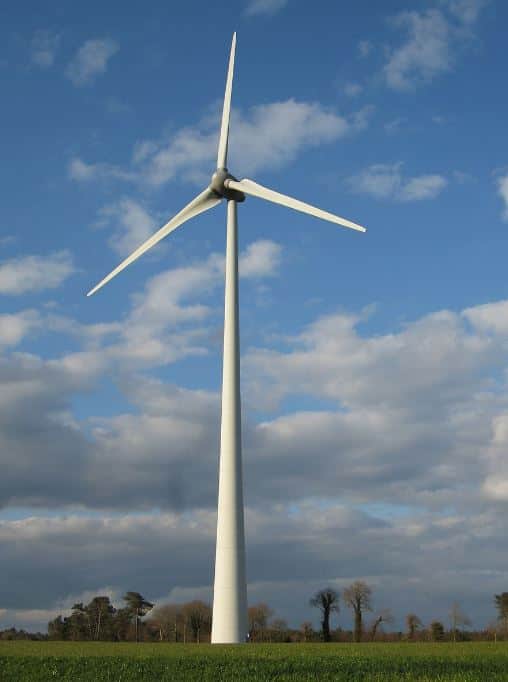
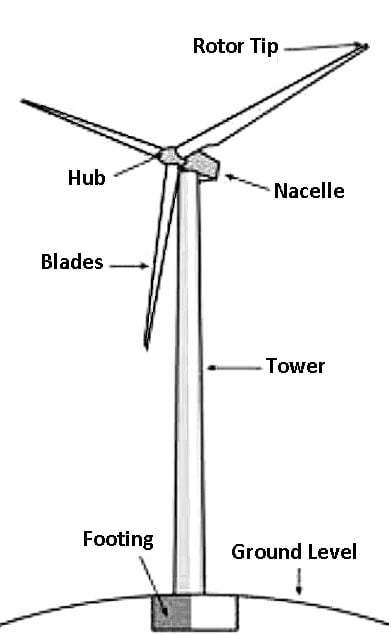
In these types of wind turbines, the axis of rotation is horizontal, and the aero turbine plane is vertically facing the wind. A common type of wind turbine with a horizontal axis is shown in the figure.
Construction of Horizontal Axis Wind Turbine
Horizontal axis windmills have the rotor shaft and electric generator at the top of the tower, and it is pointed in or out of the wind. Smaller turbines are indicated by a simple wind vane, while larger turbines use wind sensors coupled with an auxiliary motor.
Most have a gearbox, which transforms the slow rotation of the blade into a faster rotation that is more suitable for driving an electric generator.
Working of Horizontal Axis Wind Turbine
As the wind blows, a wind turbine converts the kinetic energy of the wind’s motion into mechanical energy by the rotation of the rotor, and this mechanical energy is transmitted by the shaft to the generator through the gear train. The generator further converts this mechanical energy into electrical energy, thereby generating electricity.
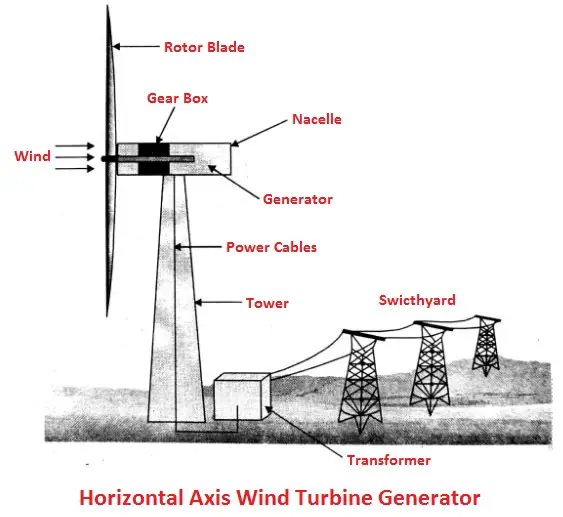
The wind passes over both surfaces of the airfoil-shaped blade but passes more rapidly over the more extended (upper) side of the airfoil, thus creating a lower-pressure area above the airfoil. The pressure differential between the top and bottom surfaces results in the aerodynamic lift.
As the blades of a wind turbine are constrained to move in a plane with the hub as the center, the lift force causes rotation about the hub. In addition to the lift force, a drag force perpendicular to the lift force prevents rotor rotation.
The main objective of wind turbine design is to have a high lift-to-drag ratio for the blades. This ratio can vary with the length of the blade to optimize the energy output of the turbine at different wind speeds. The main rotor shaft and generator are placed in the box at the top of the array, and everything is placed on top of a high column.
It is suitable for use in places where the wind factor is high because it is strong and manufactured to withstand strong forces. The disadvantages of horizontal axis wind turbines are that they require heavy construction and are often considered more unpleasant.
Read Also: Different Types of Coupling and Their Uses [PDF]
Types of Rotors for Horizontal Axis Wind Turbine
Following are the different types of rotors used for horizontal axis wind turbines:
- Multiblade type rotor
- Sail type rotor
- Propeller type rotor
- Four-blade type rotor.
The following figures show the type of blades used for HAWT.
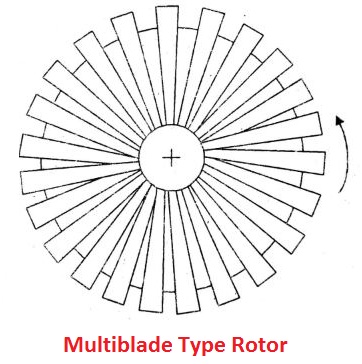
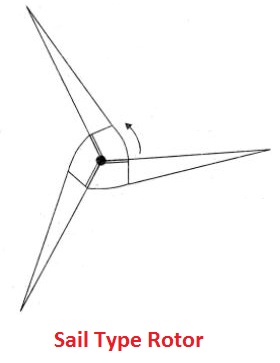
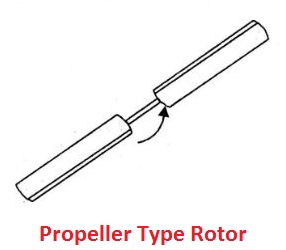
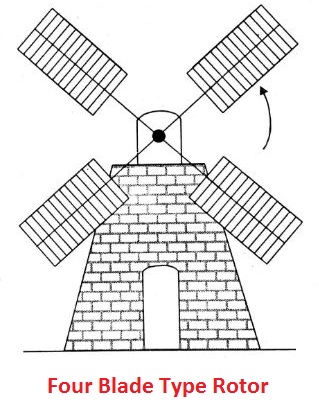
Both multi-blade and sail-type mills run at speeds of 60 to 80 rpm. The propeller type has two or three aerofoil blades and runs at a speed of 300 to 400 rpm. These rotors have to face the direction of the wind in order to generate wind power. The four-blade type rotor is shown in the figure. This motor runs at low speeds in the range of 100 to 150 rpm.
Read Also: Different Types of Furnaces: Their Advantages & Disadvantages
Advantages of Horizontal Axis Wind Turbine
The following are the advantages of a Horizontal Axis Wind Turbine:
- The tall tower base allows access to the stronger wind in sites with wind shear. In some wind shear sites, wind speeds can increase by 20% every ten meters and power output by 34%.
- High efficiency, since the blades always move perpendicularly to the wind, receiving power throughout the rotation. In contrast, all vertical axis wind turbines and the most advanced airborne and turbine designs involve various reciprocating actions, requiring the airfoil surfaces to backtrack against the wind for part of the cycle. Backtracking against the air naturally leads to lower efficiency.
Read also: Nuclear Power Plant: Layout, Working, Effects & Advantages
Disadvantages of Horizontal Axis Wind Turbine
The following are the disadvantages of a Horizontal Axis Wind Turbine:
- Massive tower construction is required to support the heavy blades, generator, and gearbox.
- Components of a horizontal axis wind turbine (gearbox, rotor shaft, and brake assembly) being lifted into position.
- Their height makes them visible over large areas, disrupting the landscape’s appearance and sometimes causing local opposition.
- The downward variant suffers from fatigue and structural failure caused by turbulence when a blade passes through the wind shadows of the towers (for this reason, most HAWTs use an inverted design, with the rotor facing the tower in front of the wind).
- HAWTs require an additional yaw control mechanism to turn the blades towards the wind.
- HAWTs require a braking or yawing device in high winds that prevents the turbine from spinning and destroying or damaging itself.
Read Also: Types of Circuit Breakers Used in Electric Circuits [PDF]
#2 Vertical Axis Wind Turbine Generator
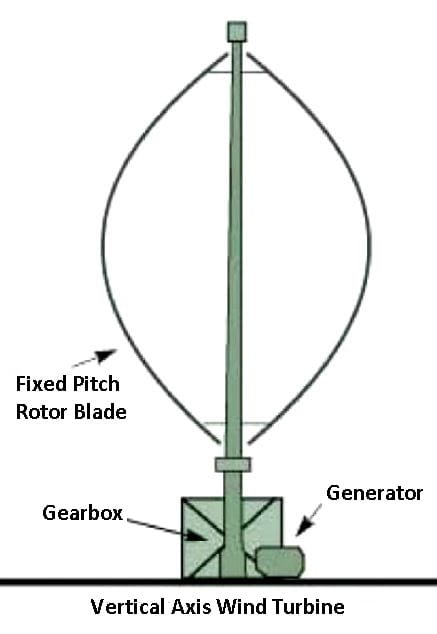
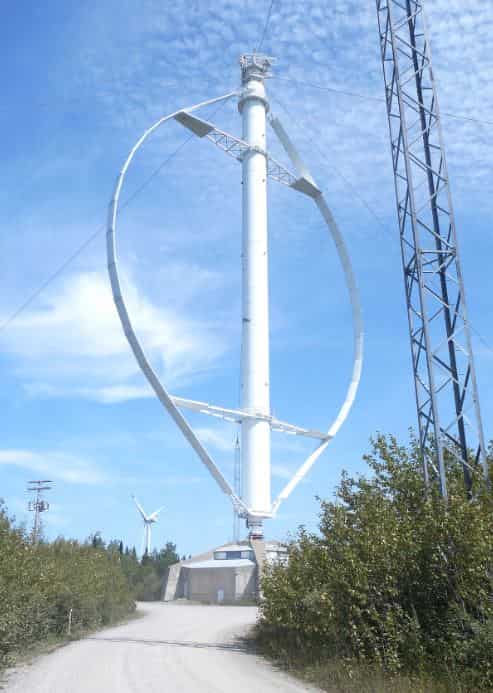
In these types of wind turbines, the axis of rotation is vertical. The sails or blades may also be vertical. Vertical axis wind turbines are a type of wind turbine where the main rotor shaft is set transverse to the wind (but not necessarily vertically) while the main components are located at the turbine’s base. This arrangement allows the generator and gearbox to be located close to the ground, facilitating service and repair.
Vertical-axis wind turbines need to be pointed into the wind, which removes the need for wind sensing and orientation mechanisms.
The major disadvantage of early designs involved notable torque differences or ripples during each revolution and large bending moments on the blade. Later designs directed the torque ripple issue by sweeping the blades helically.
A vertical axis wind turbine works sideways, tipped sideways along the axis perpendicular to the wind streamlines. A more common term that includes this option is transverse axis wind turbine or cross-flow wind turbine.
Construction of Vertical Axis Wind Turbine
Mechanical and electrical components:
- Rotor (blades and connection items)
- Braking system
- Generator
- Control system
- Tower.
#1 Rotor (blades and connection items)
Its function is to produce aerodynamic efficiency. It is constituted of light but resistant material and it is provided with a protective layer.
#2 Braking system
Its function is to stop the rotor motion in adverse weather conditions. It is constituted of disc brakes similar to those of cars and of friction brakes which function in case of failure of the electrical grid.
#3 Control system
regulates the function of the aerogenerator according to the different working conditions. It optimizes the function of the aerogenerator. This system ensures the safety and controls any further devices (anemometer).
#4 Tower
It has to withstand the action of wind and the weight of the blades. It is generally tabular, or trellis and the base can be either superfield or deep.
Read Also: Heat Treatment Process: Its Types & Applications [Explained]
Working of Vertical Axis Wind Turbine
In these types of wind turbines, the blades are aerofoil-shaped, and they can take the wind from any direction. The rotor is not self-starting. A system of guy cables supports the rotor. The base of the wind turbine rotor is coupled to a generator by a drive flexible coupling. Here the blades rotate around a vertical axis.
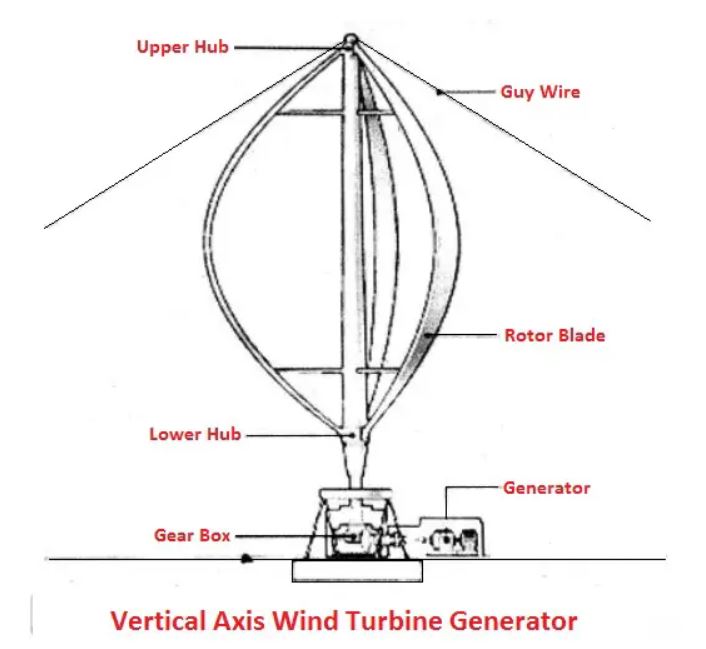
A wind turbine captures high-pressure wind, and it causes kinetic energy. This kinetic energy is converted into mechanical energy, and mechanical energy is converted into electric power.
This generated electrical power is taken by the static frequency converter from the generator at a variable frequency (0 – 20 Hz) supplies a constant frequency output (60 Hz), and feeds to the grid. The static frequency converter is controlled by a microprocessor-based control system.
Types of Rotors for Vertical Axis Wind Turbine
Following are the different types of rotors used for vertical axis wind turbines:
- Savonius type rotor
- Darrieus type rotor.
#1 Savonius Type Rotor
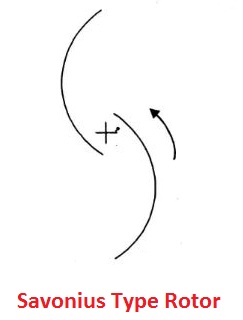
The Savonius windmill consists of a hollow circular cylinder sliced in half, two halves being fixed to a vertical axis with a gap in between. Torque is produced by the pressure difference between the two sides of the half facing the wind. This design is efficient but requires a large surface area.
#2 Darrieus Type Rotor
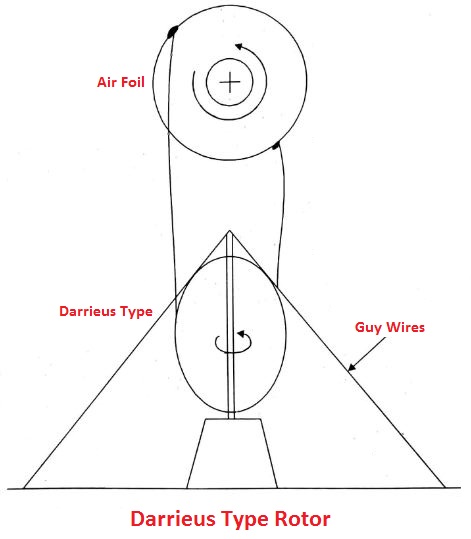
In contrast, the Darrieus type requires much less surface area. It is shaped like an egg beater and has two or three blades shaped like aerofoils.
Both the Savonius and Darrieus types run independently of the direction of the wind because they rotate about the vertical axis. On the other hand, the horizontal axis machines have to face the direction of the wind in order to generate power.
Read Also: Mechanical Properties in Mechanical Engg
Advantages of Vertical Wind Turbines
The following are the advantages of vertical wind turbines:
- More of these types of turbines can be installed on the same land because as the wind passes through them, not as much turbulence is created.
- Due to the orientation of these devices, the entire pole or shaft can be turned which makes it possible to mount the generator and other mechanisms at ground level. This makes maintenance work relatively easier.
- VAWTs don’t have to point into the wind to start up.
- Devices with this type of design are more muscular than horizontally oriented units. Because they do not have to go in the air, they do not need a tail section to keep the rotor blade assembly on the airside. These units are less likely to sustain damage during gusty wind conditions than traditionally designed units.
- They don’t need as much wind to generate power which means they can be installed closer to the ground.
- The vertical orientation of the blades often results in these devices being quieter than standard turbines.
- Since tall towers aren’t necessary, installation and maintenance costs are reduced.
Disadvantages of Vertical Wind Turbine
The following are the disadvantages of vertical wind turbines:
- While this design is less likely to be damaged by gusty wind conditions, they are more likely to stall out and stop spinning.
- These types of turbines aren’t typically well suited for use in areas of high wind speeds.
- Due to the vertically oriented blade design, the blades flex and turn faster and faster as the rotor assembly. The centrifugal force generated by the spinning blade has been reported to cause stress and fatigue on some blade designs, which sometimes results in them breaking.
Closing It Up
That’s it, thanks for reading. If you have any questions about “types of wind turbine” ask in the comments. If you like this article, please share it with your friends. Want free PDFs direct to your inbox? Then subscribe to our newsletter.
Download PDF of this article:
Read Next:
- Understand The Different Types of Heat Exchangers
- 10 Types of Air Conditioning Systems and Their Applications
- Different Types of Solar Panel (PDF): Their Working & Advantages
External Links: